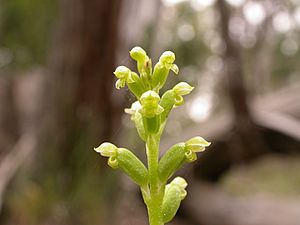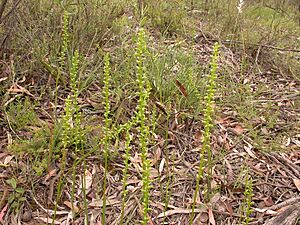Slender onion-orchid facts for kids
Quick facts for kids Slender onion-orchid |
|
|---|---|
 |
|
| Microtis parviflora growing on Black Mountain in the A.C.T. | |
| Scientific classification | |
| Genus: |
Microtis (plant)
|
| Species: |
parviflora
|
The slender onion-orchid (Microtis parviflora) is a type of orchid. It grows naturally in Australia and New Zealand. You can find it in most Australian states, but not in the Northern Territory. It might not grow in Western Australia either.
Like other onion-orchids, it has one tall, smooth leaf shaped like a tube. It can have up to eighty small flowers on a straight stem.
What Does the Slender Onion-Orchid Look Like?
The slender onion-orchid is a plant that grows from the ground. It's a perennial plant, meaning it lives for more than two years. It's also deciduous, so it loses its leaves. It has a tuber (like a small potato) underground.
It grows a single, smooth leaf shaped like a tube. This leaf is usually 20 to 50 centimeters (about 8 to 20 inches) long. The leaf has a pointed tip and is often longer than the flower stem.
Between ten and eighty small, green flowers grow closely together on a straight, thick flower stem. This stem can be 20 to 50 centimeters (about 8 to 20 inches) tall. Each flower has a tiny stalk, about 1 millimeter (0.04 inches) long. This stalk helps the flower stand out from the main stem.
The bottom part of the flower, called the ovary, is oval-shaped. It is about 3 to 5 millimeters (0.12 to 0.20 inches) long. The top sepal (a leaf-like part) is egg-shaped or round. It is about 2 millimeters (0.08 inches) long. This sepal, along with the petals, forms a hood over the flower's central part, called the column.
The side sepals are thin and slightly shorter than the top sepal. They curl back as the flower gets older. The labellum (a special petal) is 1 or 2 millimeters (0.04 to 0.08 inches) long. It is somewhat heart-shaped and curves downwards. At the base of the labellum, there are two relatively large, egg-shaped bumps called calli.
Slender onion-orchids usually flower from October to February. In New Zealand, they can flower until March.
How Was the Slender Onion-Orchid Named?
The slender onion-orchid was first officially described in 1810. This was done by a botanist named Robert Brown. He published his description in a book called Prodromus Florae Novae Hollandiae et Insulae Van Diemen.
The second part of its scientific name, parviflora, comes from two Latin words. Parvus means "small," and flos means "flower." So, parviflora basically means "small-flowered," which describes its tiny blooms.
Where Does the Slender Onion-Orchid Grow?
The slender onion-orchid grows in all states of Australia, except for the Northern Territory. There is some uncertainty about whether it grows in Western Australia. However, some experts believe it can be found in the dry areas of that state.
In Australia, this orchid is common and can be found in many different places. It usually prefers moist soil. In New Zealand, it grows on both the North and South Islands. There, it often grows in areas where there isn't much plant cover above it.


